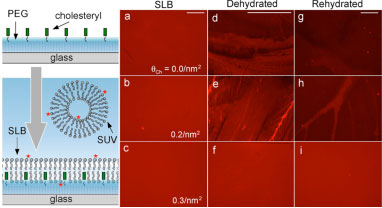05/14/2008
Fluidic and air-stable supported lipid bilayer and cell-mimicking microarrays
Recent research from the group of Professor Xiaoyang Zhu.
An academic-industrial research team led by Professor Xiaoyang Zhu of UMN
and Dr. Athena Guo of MicroSurfaces, Inc. reported a ground-breaking discovery
on biomaterials and biotechnology in the latest issue of the Journal of the
American Chemical Society (DOI:10.1021/ja800049f).
The first author on the paper was chemistry graduate student Yang Deng. As
drug delivery, therapy, and medical imaging are becoming increasingly cell-specific,
there is a critical need for high fidelity and high-throughput screening
methods for cell surface interactions. Cell membrane-mimicking surfaces,
i.e., supported lipid bilayers (SLBs), were not sufficiently robust to meet
this need. Learning from nature, particular biophysics of the magic molecule
cholesterol, this research team designed and developed a novel surface with
tethered and dispersed cholesterol groups. They discovered that SLBs formed
on such a designer surface became air-stable due to the cooperative stabilizing
effect of the tethered cholesterol groups incorporated into the bottom leaflet.
Achieving air-stability allowed the team to easily fabricate SLB microarrays
from direct robotic spotting of vesicle solutions. They further demonstrated
the application of the SLBs as cell membrane-mimicking microarrays by reconstituting
peripheral as well as integral membrane components that can be recognized
by their respective targets. These demonstrations established the viability
of the fluidic and air-stable SLB platform for generating content microarrays
in high throughput studies, e.g., the screening of drugs and nanomedicine
targeting cell surface receptors.

Fluorescence microscopy images of supported lipid bilayers formed on a PEG brush surface with the indicated densities of surface tethered cholesteryl groups: qCh = 0.0 (a, d, g), 0.2 (b, e, h), and 0.3/nm2 (c, f, i). The scale bar (0.4 mm) for each column is shown at the top. The SLBs are formed from the fusion of solutions of small unilamellar vesicles containing 0.5% red dye-tagged lipids. |